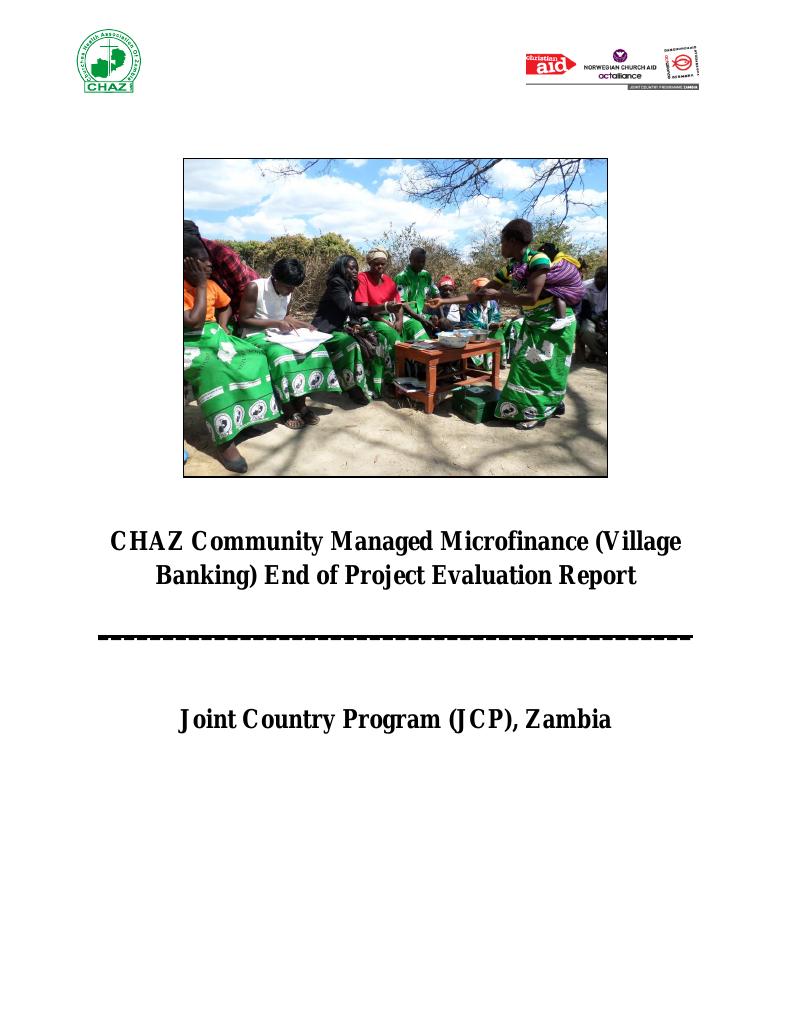Evaluering
CHAZ Community Managed Microfinance (Village Banking) End of Project Evaluation Report
Background: Community-Managed Microfinance (CMMF) methodology has been implemented by some Microfinance Institutions and NGOs worldwide. CMMF programmes create small-scale community-based Savings and Credit Associations (CSCAs) with between 5 and 30 members, who regularly save and pool their money into a fund from which any of the members can borrow. These associations are characterised by very high rates of sustainability and by being able to operate successfully in rural areas, where formal Financial Institutions (FIs) may not be able to reach, offering finance to cover emergencies, savings and credit for business investment/ IGAs. CHAZ adopted the use of IGAs in 2000 as an integral part of its health programs at community level with support from Danchurch AID (DCA). It took a step further in 2010 to introduce and implement the CMMF pilot project in the communities of Chipembi CHI with support from DCA. The successes of the pilot project resulted in introducing the activities to communities of St. Theresa’s Mission Hospital, Mishikishi RHC in 2012 and 2013 respectively. The project is an innovative strategy that aims at assisting the poor in CHAZ rural communities that include PLWHAs, youths and OVCs to encourage a culture of saving and have access to finances2.The project is currently supported by Norwegian Church AID (NCA), DCA, and Christian AID (CA)– Joint Country Program (JCP). CHAZ selected the above areas as places in which to provide CMMF based on those communities having no financial services presence in their catchment areas and having residents who were desirable potential savers and borrowers, but vulnerable. Objectives: Purpose of the Evaluation The purpose of the evaluation is to provide CHAZ, its partners and stakeholders information on the extent to which the goal and objective of the project have been achieved. Specifically, the evaluation will assess the project and its activities for their relevance, effectiveness, efficiency, impact and sustainability. Specific Objectives of the Evaluation 1. Assess the delivery mechanisms of the project in contributing to the intended project outputs. 2. Assess the project’s contribution to the improvement of Financial and Food security of the target beneficiaries. 3. Assess the extent to which the project has contributed to: (i) Increased acquisition of household assets, (ii) Increased utilisation of education and health services (iii) Improved social status of participants (iv) Increased utilisation of informal Financial Services (v) Assess project’s contribution to mitigation of social economic impacts of HIV and AIDS, especially among the most vulnerable groups (OVCs, PLWHIV and vulnerable households). (vi) Identify both strengths and weakness in the manner in which the project was implemented (vii) Give recommendations on how best the performance of the program could be enhanced in future. Methodology: A variety of desk and field data collection tools were used. Literature was reviewed. Semi structured interviews (in form of personal interviews, transect walks and focus group discussions) were conducted in 3 target districts: Chipembi (Chisamba District), Mishikishi (Masaiti District) and St. Theresa’s (Mpongwe District) to collect qualitative data. Quantitative data was collected from the same districts through group surveys and individuals surveys administered. Key findings: 1. Savings Groups (SGs) can improve the economic outcomes of poor households (vulnerable groups). It is clear that for beneficiaries of the programme; most often the programme has been a clear source of recourse for families that have very limited resources. 2. It is also evident that participation in Churches Health Association of Zambia (CHAZ) Community Managed Micro-finance (CMMF) intervention had a strong impact on household economic outcomes. The results of the study show that participation in the intervention had a significant impact on household assets – which are indicative of longer-run income - and consumption, a measure of current income. 3. Obtaining assets requires a considerable lump sum investment. Because of this, and because the first cycle in any CMMF is typically characterized by relatively low values of shares and small loans, there is reason to believe that a single CMMF cycle will have a minimal impact on members' assets. However, the findings show that the CHAZ CMMF intervention significantly increased household assets amongst the group members. 4. Though training was done in CMMF SGs, most group members feel that the training was inadequate. This could be attributed to the inability of the project to produce pictorial guidelines that the trainers (FOs and FAs) could have been using for the training sessions. It is evident in the findings that even when group members were running small scale businesses, they lacked training in basic business skills, IGAs, entrepreneurship, financial education and financial Inclusion. Recommendations: 1. Although some partners do not encourage remunerating of Field Officers (FOs) and Field Agents (FAs), CHAZ should continue to motivate FOs and FAs for the project period then after clients and the trainers (FOs and FAs ) agree on a professional fee so that beyond the project period new groups formed pay a training fee to the FOs and FAs. 2. Although FOs and FAs have been trained, and are in turn conducting training in their catchment areas, it is important that more simplified training manuals on CMMF are printed and provided to them to implement training interventions effectively. In addition, CHAZ should consider producing materials on CMMF in form of printed pictorial charts which can also be used during training as they are easier to understand. 3. The large area coverage of some CHIs means that FOs and FAs need to cover long distances to monitor remote saving groups. The long distances covered coupled with use of bicycles mean that field officers are unable to monitor or visit some groups in their areas. A good example is in Chipembi were one FO covers the central and southern part (Kanakantampa) which is more than 30kms from the CHI (Therefore, it would be helpful for CHAZ in consultation with the CHI to engage two FOs to manage the project and provide motor bikes to FOs
